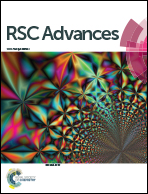Direct laser micropatterning of GeSe2 nanostructures film with controlled optoelectrical properties†
Abstract
We demonstrate that a direct focused laser beam irradiation is able to achieve localized modification on GeSe2 nanostructures (NSs) film. Using a scanning focused laser beam setup, micropatterns on GeSe2 NSs film are created directly on the substrate. Controlled structural and chemical changes of the NSs are achieved by varying laser power and the treatment environment. The laser modified GeSe2 NSs exhibit distinct optical, electrical and optoelectrical properties. Detailed characterization is carried out and the possible mechanisms for the laser induced changes are discussed. The laser modified NSs film shows superior photoconductivity properties as compared to the pristine nanostructure film. The construction of micropatterns with improved functionality could prove to be useful in miniature optoelectrical devices.


 Please wait while we load your content...
Please wait while we load your content...